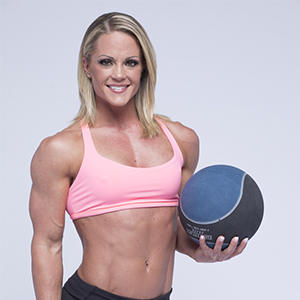By Nicole
There’s a fairly easy, but often overlooked way to make sure your workouts are helping you move forward, and closer to your goals. It’s used by world class athletes, physique competitors, and trainers everywhere.
It’s called periodization.
This is a pre-planned way to achieve peak performance for a sporting events, physique contests, or attaining personal goals. It forces your body to adapt to different stimuli over a prescribed time frame. It’s also keeps track of your progress, as you’ll know if strength or endurance levels (depending on your goals) are improving or dropping from week to week. Here are the three main types of periodization.
LINEAR PERIODIZATION
Start with light weights and high reps and gradually transition to heavier weights for lower reps.
Week 1 12-15 reps
Week 2 10-12 reps
Week 3 8-10 reps
Week 4 6-8 reps
REVERSE LINEAR PERDIODIZATION
Start with heavy weights and low reps, then gradually transition to lighter weights for higher reps.
Week 1 6-8 reps
Week 2 8-10 reps
Week 3 10-12 reps
Week 4 12-15 reps
UNDULATING PERIODIZATION
Weight loads and rep ranges change from week to week.
Week 1 12-15 reps
Week 2 3-5 reps
Week 3 10-12 reps
Week 4 6-8 reps
The basic premise of each of these training protocols is the same: weights and rep ranges change/vary because you simply can’t train at maximum intensity, volume, poundage, or any other variable for extended periods and not overtrain.
Just like using the same weights and reps for weeks on end and never switching things up – whether it’s train heavier, changing reps or rest periods, incorporating different intensity techniques – will eventually lead to stagnation. Your body will adapt and you’ll stop making progress.
For example, powerlifters plan their training so that their weights get progressively heavier closer to the meet. It does no good to start training at or near peak weights 12-16 weeks before the meet. You will burn out. Of if you’re training for a marathon later in the year, you don’t start by running a marathon every week for months on end. You build up to it gradually (especially if it’s your first marathon).
The same holds true for physique goals, whether it’s getting stronger, adding muscle, dropping body fat, improving endurance, etc. You take progressive steps to reach your ultimate goal by managing training variables and degree of effort.
The time frames I’ve used above can be adjusted. You can do shorter cycles (3 weeks) or longer ones (6-8 weeks, or even more). You can do 4 weeks of linear, then 3 weeks of reverse linear, followed by 2 weeks of undulating. The combinations are endless.
The takeaway here is that all three periodization plans are different and each should be utilized consistently to keep your training fresh and productive.
Looking for more awesome training and nutrition information? Join NicoleWilkins.com for hundreds of workouts, training and nutrition tips, healthy recipes and more to help you transform your body and reach your fitness goals!
Become a Member Today!
ABOUT NICOLE
 One of the biggest names in the fitness industry, Nicole Wilkins is a world-record holding four-time Figure Olympia Champion and 2012 IFPA Personal Trainer of the Year. Nicole earned her BA in Wellness, Health Promotion and Injury Prevention at Oakland University. The owner and founder of nPower Nutrition, Nicole has helped thousands of people start living a healthier lifestyle and reach their fitness goals.
One of the biggest names in the fitness industry, Nicole Wilkins is a world-record holding four-time Figure Olympia Champion and 2012 IFPA Personal Trainer of the Year. Nicole earned her BA in Wellness, Health Promotion and Injury Prevention at Oakland University. The owner and founder of nPower Nutrition, Nicole has helped thousands of people start living a healthier lifestyle and reach their fitness goals.


